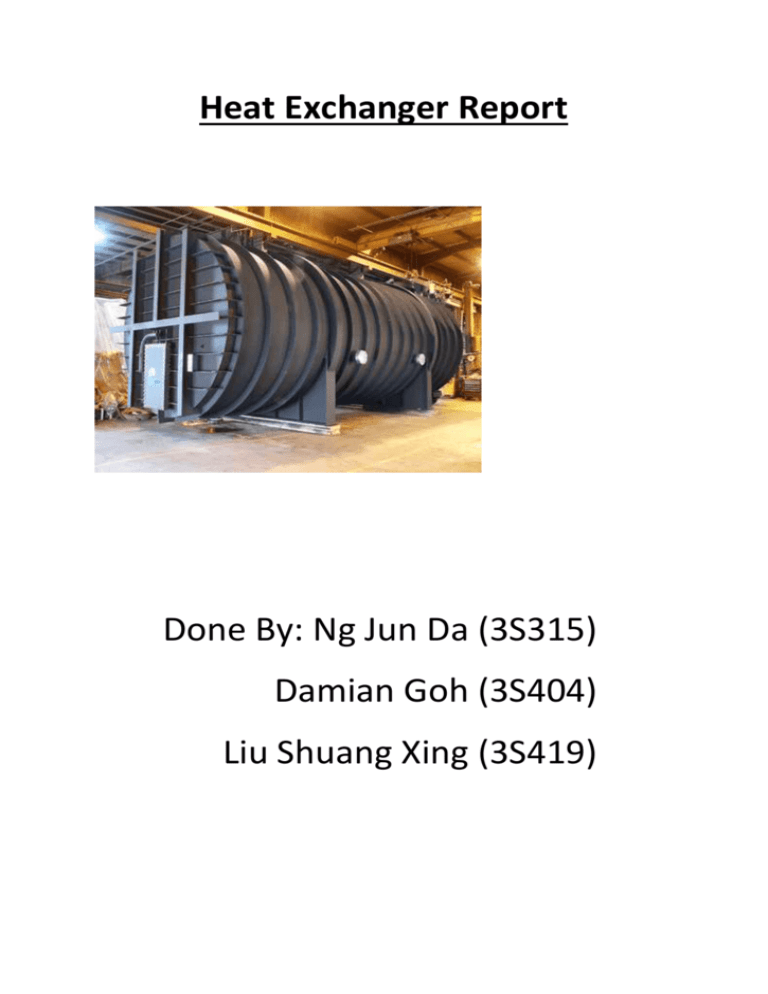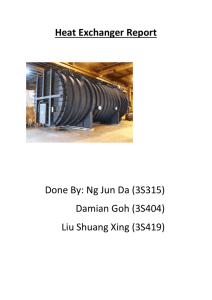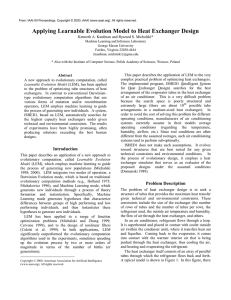PBL - m4group7
advertisement

Heat Exchanger Report Done By: Ng Jun Da (3S315) Damian Goh (3S404) Liu Shuang Xing (3S419) Conversion of Information to SI units Mass flow rate = 30000 lb/h = 13 607.7711 Kg/h Crude oil heated from 70 F to 136 F is equivalent to raising temperature from 21.11°C to 57.78°C Product to be cooled from 295 F to 225 F is equivalent to lowering temperature from 146.11°C to 107.22°C Properties of crude oil Specific Heat Capacity = 0.475 BTU/lbF = 1988.73 J/kg°C Viscosity = 2.9 mPa.s = 0.00029 N.s/m2 Thermal Conductivity = 0.13646364152 W/m.K Density = 51.5 lb/ft³ = 824.95086376 kg/m3 Properties of Product Specific Heat Capacity = 0.525 BTU/lbF = 2198.07 J/kg °C Viscosity = 5.2 mPa.s = 0.00052 N.s/m2 Thermal Conductivity = 0.11934082719 W/m.K Density = 54.1 lb/ft³ = 866.59886853 kg/m3 Specifications of heat exchanger Shell diameter: 23.25 in = 0.59055m No. of tubes: 324 Type of tubes: BWG 14 arranged on a 1 inch square patch, supported by baffles Length of tubes: 12 ft = 365.76 cm = 3.6576m Outer diameter of tubes: 0.75 in = 1.905 cm = 0.01905m Baffles: 25% cut 22.86 cm intervals. Inner diameter: 0.584 in = 0.0148336m Thickness of tube wall: 0.083 in =0.0021082m Surface area of all tubes = 𝜋 × 0.0148336 × 3.6576 × 324 = 𝟓𝟓. 𝟐𝟐𝟓𝟐𝟒𝐦𝟐 Volume of Oil = 𝜋𝑟 2 × 𝑙 = 𝜋(0.0148336 ÷ 2)2 × (3.6576 × 324) = 0.2047973005 m³ Mass of Oil = volume x density =168.9477092 kg Temperature oil increases = 57.78°∁ − 21.11°∁= 𝟑𝟔. 𝟔𝟕°∁ Heat energy to be gained by crude oil to increase by 36.67 deg C = Specific Heat Capacity × Mass of Oil × ∆𝑇𝑒𝑚𝑝𝑒𝑟𝑎𝑡𝑢𝑟𝑒 = 1988.73𝐽/𝐾𝑔℃ × 168.9477092𝐾𝑔 × 36.67℃ = 𝟏𝟐𝟑𝟐𝟎𝟖𝟎𝟑. 𝟖𝟐𝑱 Calculations Reynolds number for Oil Density = 824.95086376 kg/m3 cross section area of tube = 𝜋𝑟 2 =𝜋×( 0.0148336 2 ) 2 =0.000172813𝑚2 Velocity = 𝑚𝑎𝑠𝑠 𝑓𝑙𝑜𝑤 𝑟𝑎𝑡𝑒 𝑑𝑒𝑛𝑠𝑖𝑡𝑦 𝑜𝑓 𝑜𝑖𝑙 × 𝑐𝑟𝑜𝑠𝑠 𝑠𝑒𝑐𝑡𝑖𝑜𝑛 𝑎𝑟𝑒𝑎 𝑜𝑓 𝑡𝑢𝑏𝑒 × 3600 Velocity = 𝟐𝟔. 𝟓𝟏𝟑𝟎𝟗𝟓𝟕m/s Diameter = 0.0148336m Viscosity = 0.00029 N.s/m2 Reynolds number = (density x velocity x diameter)/viscosity =8.82 x105 (Substitute approprite values) http://www.efunda.com/formulae/fluids/calc_reynolds.cfm#calc Re > 4000, Therefore Movement of Oil = Turbulent Flow Heat Transfer Coefficient Whereby ΔQ = heat input or heat lost, J h = heat transfer coefficient, W/(m2K) A = heat transfer surface area, m2 ΔT = difference in temperature between the solid surface and surrounding fluid area, K Δt = time period, s ΔQ = 𝟏𝟐𝟑𝟐𝟎𝟖𝟎𝟑. 𝟖𝟐J A = 𝟓𝟓. 𝟐𝟐𝟓𝟐𝟒𝐦𝟐 ΔT =𝟏𝟒𝟕. 𝟏𝟏 − 𝟐𝟏. 𝟏𝟏 = 𝟏𝟐𝟓°∁ Δt = 𝑑𝑖𝑠𝑡𝑎𝑛𝑐𝑒 𝑣𝑒𝑙𝑜𝑐𝑖𝑡𝑦 3.6576×324 = 26.5130957 = 44.69587544s HTC = 12320803.82 55.22524×125℃×44.68587544 =𝟑𝟗. 𝟗𝟑𝟐𝟐𝟔𝟕𝟑 𝑾/𝒎𝟐 ℃ Rate of Heat Transfer q = hA(Ts − Tb) A - surface area of heat transfer. Ts - surface temperature Tb - temperature of the fluid at bulk temperature. h - constant heat transfer coefficient h= 𝟑𝟗. 𝟗𝟑𝟐𝟐𝟔𝟕𝟑 𝑾/𝒎𝟐 ℃ A= 𝟓𝟓. 𝟐𝟐𝟓𝟐𝟒𝐦𝟐 Ts-Tb = 𝟏𝟐𝟓°∁ q = 39.9322673 × 55.22524 × 125 = 275658.6307W Efficiency E= q qmax E: efficiency = q Cc (Th − Tc ) q: heat transfer rate Cc: mass flow rate x heat capacity of cool substance T: Temperature of hot/cool substance q = 275658.6307W Mass flow Rate = 13 607.7711 Kg/h = 3.779936 Kg/s Cc = 3.779936 x 2198.07 = 8308.564839W℃ Th − Tc = 146.11 − 21.11 = 𝟏𝟐𝟓℃ E= q qmax = 𝟐𝟕𝟓𝟔𝟓𝟖.𝟔𝟑𝟎𝟕 𝟖𝟑𝟎𝟖.𝟓𝟔𝟒𝟖𝟑𝟗(𝟏𝟐𝟓) =0.265421175 ∴ Efficiency = 26.5% (3 Sig. Fig.) Conclusion From the above data, we conclude that at an efficiency percentage of 26.5%, the heat exchanger is not efficient. Thus we need to redesign a more effective heat exchange Ways to improve Heat Exchanger 1. Increase the number or length of tubes 2. Increase the mass flow rate 3. Use a product of higher specific heat capacity 4. Increase the temperature difference between the product and the oil









